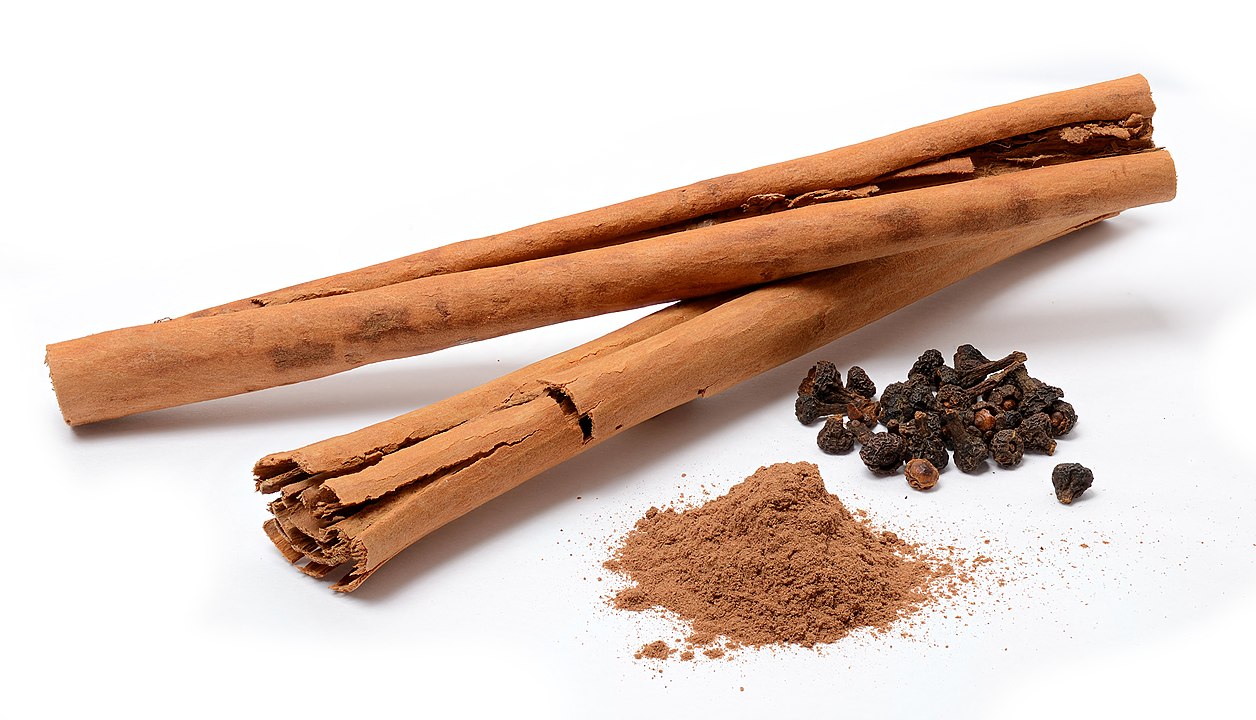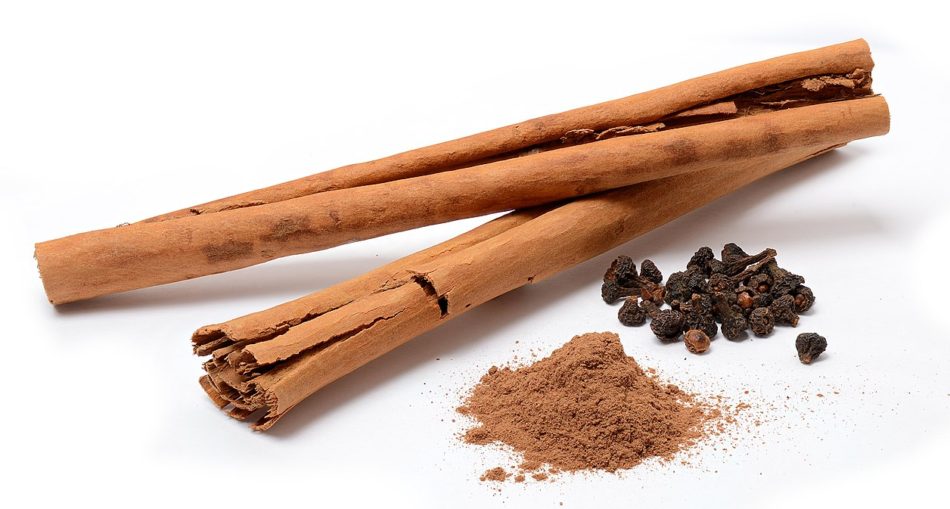Cinnamon is one of the spices that you can be sure to find in a Guyanese household. You will find it among nutmeg, clove, ginger and allspice, in your local supermarket or grocery store. Cinnamon is produced from the plant species Cinnamomum verum or cinnamomum zeylanicum also known as ‘true’ Cinnamon and Cinnamomum cassia, simply cassia, in the genus of trees called Cinnamomum. Cinnamon is made of the stripped and dried bark of the evergreen Cinnamomum trees. This aromatic spice flavours lots of sweet and savoury dishes cereals and even teas!

Cinnamon Sticks and Powder – By Simon A. Eugster – Own work, CC BY-SA 3.0, https://commons.wikimedia.org/w/index.php?curid=39582136
Origin of Cinnamon
‘True’ Cinnamon or Ceylon Cinnamon is indigenous to Sri Lanka, India, Myanmar and Bangladesh whereas Cassia Cinnamon is native to China. Some other species harvested in this modern age is native to Indonesia Vietnam, and other southeast Asian countries with warm climates. It is also grown throughout Europe, and North America.
Interesting Tip
- Sri Lanka was named Ceylon and was under British rule.
What is Cinnamon?
Cinnamon is the dried inner bark of Cinnamomum verum and Cinnamomum cassia trees. The outer bark is removed and then the inner bark of these trees is acquired which is made into cinnamon. After removal the strips of inner bark is left to dry. They naturally curl into Cinnamon sticks, also called quills. Sticks of Cinnamon can be added whole to dishes like sweet rice, to add flavour but some people prefer ground Cinnamon. Ground Cinnamon is the powder form of this spice that is made by grinding them. Cinnamon extracts are also made by submerging the bark in alcohol and then straining out any remaining solids.
Ceylon Cinnamon
Ceylon Cinnamon from the Cinnamomum verum tree is consists of many tightly formed sticks with soft layers-desirable qualities and textures. The colour of Ceylon Cinnamon is tan-brown and has a sweet, exquisite flavour- fit for adding to desserts. Ceylon Cinnamon is rarer than Cassia. Because Ceylon is very expensive it is highly prized as a cooking spice.
Cassia Cinnamon
Cassia Cinnamon is obtained from Cinnamomum cassia or Cinnamomum aromaticum trees. These Cinnamon sticks are thicker than Ceylon, coarser and are a dark, reddish-brown in colour. It is pungent in flavour and aroma. Cassia Cinnamon is cheaper than Ceylon Cinnamon.
Nutrition Facts of Cinnamon
Cinnamon is a great source of nutrients and is typically added to many foods and drinks because of this. Cinnamon contains 0.3 g 1% of Saturated fat, fat 0.1 g Polyunsaturated fat,0.2 g Monounsaturated fat, 0 g Trans fat, 0 mg 0%, Cholesterol, 10 mg 0% Sodium, 431 mg 12% Potassium, 81 g 27% Total Carbohydrate, 53 g 211% Dietary fiber, 2.2 g Sugar, 4 g 8% Protein, 5% Vitamin A, 6% Vitamin C, 100% Calcium, 46% Iron, 0% Vitamin D, 10% Vitamin B-6, 0% Cobalamin and 15% of Magnesium.
Top 10 Health Benefits of Cinnamon
- Treats Diabetes – According to a Certified Nutrition Consultant, Lori Kenyon Farley, Cinnamon helps to manage Type 2 Diabetes. It is believed that it reduces blood pressure and the body’s insulin resistance which lowers fasting blood sugar levels by up to 29%. Cinnamon forces the muscle cells to remove sugar from the bloodstream, where it is converted to energy. Receptors are repaired so they are responsive to insulin again.
- Helps with Metabolic Diseases – Reviews have found cinnamon could be effective in reducing blood pressure, dyslipidemia, obesity, plasma glucose, complications, morbidity, and mortality in metabolic syndrome. However, more in-depth research needs to be done.
- Lowers ‘bad’ Cholesterol – It is believed that Cinnamon improves serum glucose, lowering fasting blood glucose, and reducing triglycerides, LDL cholesterol, and total cholesterol while raising HDL, the good cholesterol which removes LDL from our bodies. Regular use of this spice may reduce the effects of high-fat meals by slowing the increase in blood sugar after a meal.
- Antimicrobial Properties – Cinnamon fights anything from lung problems to the common cold. It is known to combat fungal, bacterial, and viral elements in foods. In addition, a cinnamon extract prevents the HIV virus from entering cells and may help fight the virus.
- Treats Symptoms of Alzheimer’s and Parkinson’s diseases – Cinnamon helps neurons and improve motor function in those suffering from these two diseases.
- Anti-inflammatory Properties – Consuming Cinnamon can significantly reduce systemic and specific inflammation in humans. It could help to treat certain headaches and pains including arthritis pains by stimulating circulation in joints.
- Antioxidant Properties – Cinnamon has strong antioxidant benefits and its high concentration of antioxidants can aid in the body’s protection from free radicals damage, reduce inflammation, and reduce risk of cancer and other diseases.
- Helps Eyes – When used with herbs, Cinnamon can help to treat eye disorders like conjunctivitis and dry eye.
- Insect repellent – Cinnamon is a natural insect repellent.
- Good for Females – This spice treats Polycystic ovarian syndrome and may help mitigate heavy menstrual bleeding associated with common female health conditions like endometriosis, menorrhagia, and uterine fibroids.
Uses of Cinnamon
- Cinnamon is a key ingredient in cakes, pies, cookies, cobblers, puddings, and other desserts but is also sprinkled on oatmeal and breakfast cereals.
- A marinade for beef, venison, or lamb can be flavoured with cinnamon.
- Cinnamon sticks are often added to hot drinks like tea, cocoa, hot chocolate or cider to add flavour.
- Cinnamon is typically added to Indian meat dishes, rice and chutneys.
- Cinnamon has been used in both Chinese medicine and Indian Ayurvedic traditions to treat a number of ailments and disorders.
Interesting Tip
- In Rome, Cinnamon was used to purify the way of the dead by burning them on funeral pyres.
- Cinnamon was used in the Egyptians mummification process.
- A tea made from Cinnamon is drunk to relieve stress in Sri Lanka.
About Cinnamon
There is little that can compare to the irresistible aroma of the Cinnamon spice, whether it is added to hot chocolate, in a cinnamon roll or in a curry. It is also widely used for its many health benefits including antimicrobial and anti-inflammatory and antioxidant properties. Once one of the most expensive and rarest spices in the world, Cinnamon is now available to anyone almost anywhere in the world. Take advantage of this fact knowing it doesn’t just taste good, but it’s great for you. So, the next time you’re looking for a littl elevation to your dish, add a dash of cinnamon.
Article References
- https://en.wikipedia.org/wiki/Cinnamomum
- https://www.everydayhealth.com/diet-nutrition/diet/cinnamon-nutrition-benefits-types-recipes/
- https://www.spiceadvice.com/encyclopedia/cinnamon
- https://www.organicauthority.com/health/11-health-benefits-of-cinnamon
- https://www.bespokespices.com/uses-of-cinnamon.html
- https://science.howstuffworks.com/life/botany/cinnamon2.htm








2 Comments